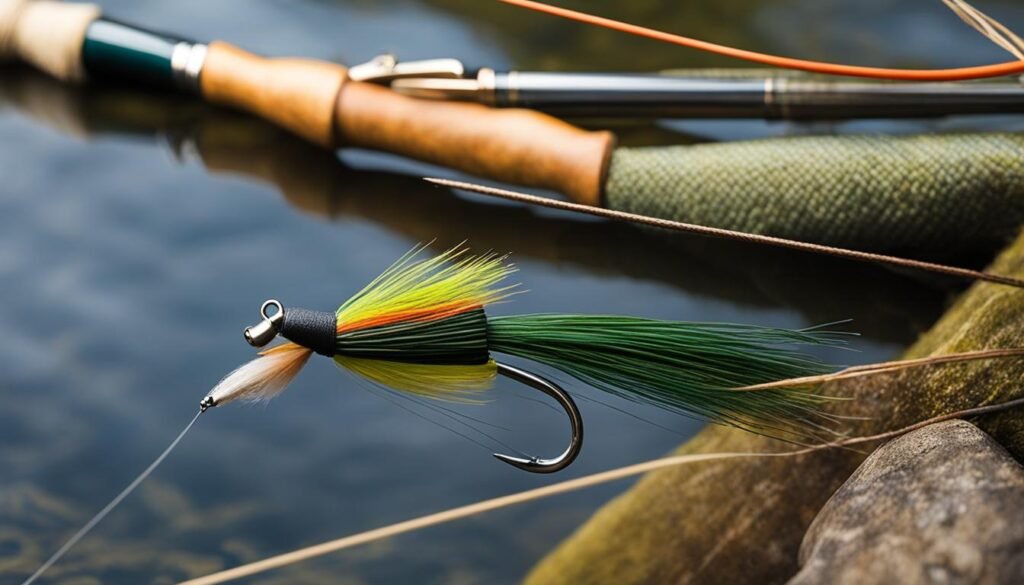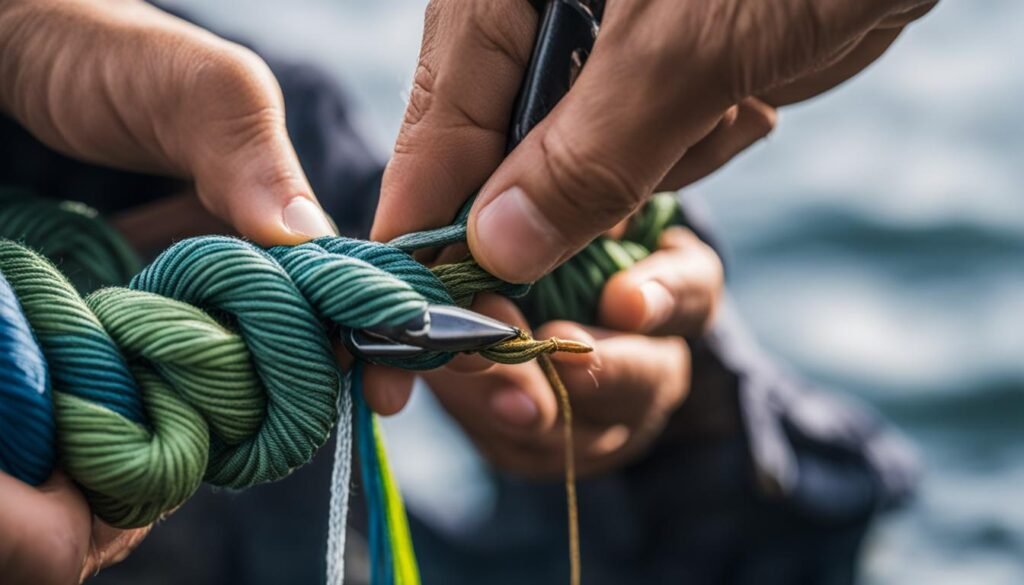Tying knots is one of the foundational skills in fly fishing. Whether you’re a beginner or an experienced angler, knowing the right knots can make a huge difference in your success on the water. In this guide, we’ll cover the essential fly fishing knots that every angler should know. We’ve gathered information from multiple sources to provide you with a comprehensive overview of these knots and their uses.
The Clinch Knot
The Clinch Knot is a fundamental fly fishing knot that every angler should know. It is commonly used to attach the fly to the tippet, ensuring a secure connection during fishing. This knot is known for its strength and reliability, making it a popular choice among fly anglers.
To tie the Clinch Knot, start by passing the tippet through the eye of the hook. Then, make 5 to 7 turns around the standing line. After that, pass the tag end of the tippet through the small loop that has been formed just above the eye of the hook. Finally, moisten the knot and tighten it by pulling only the long end of the tippet. This will ensure a tight and secure connection.
The Clinch Knot is relatively easy to tie, making it suitable for beginners in fly fishing. With its simplicity and strength, this knot is a valuable addition to your repertoire of fly fishing knots. Practice tying the Clinch Knot and master it, as it will serve you well on your fly fishing adventures.
| Advantages of the Clinch Knot | |
|---|---|
| 1. Strong and reliable connection | Ensures that the fly remains securely attached to the tippet during fishing. |
| 2. Easy to tie | Can be quickly learned and mastered, making it suitable for beginners. |
| 3. Versatile | Can be used with a variety of fly patterns and tippet materials. |
Quick Tips:
- Moisten the knot before tightening to reduce friction and prevent damage to the tippet.
- Ensure that the knot is tightened by pulling only the long end of the tippet.
- Trim any excess tippet after tying the knot to avoid interference with the fly’s movement in the water.
The Surgeon’s Knot
The Surgeon’s Knot is a strong and versatile knot that is widely used in fly fishing. It is commonly used for connecting two pieces of leader material, whether it’s monofilament or fluorocarbon. This knot is known for its simplicity and speed, making it a favorite among anglers.
To tie the Surgeon’s Knot, follow these steps:
- Create a loop with both ends of the leader material
- Pass the ends of the leader material through the loop once
- Moisten the knot and pull tight
This simple yet effective knot creates a secure connection that holds up well even in challenging conditions. Whether you’re joining two pieces of leader material of the same diameter or different diameters, the Surgeon’s Knot is a reliable choice.
Advantages of the Surgeon’s Knot:
- Strong and secure connection
- Simple and quick to tie
- Works well with various types of leader material
Mastering the Surgeon’s Knot is an essential skill for any fly angler. It provides confidence in knowing that your leader connections are strong and reliable, allowing you to focus on the art of fly fishing itself.
| Knot | Strength | Difficulty |
|---|---|---|
| Surgeon’s Knot | High | Easy |
| Clinch Knot | Medium | Easy |
| Blood Knot | High | Medium |
| Nailless Nail Knot | High | Medium |
The Blood Knot: An Essential Fly Fishing Knot
When it comes to fly fishing knots, the Blood Knot is one that every angler should have in their arsenal. This knot is commonly used to connect two pieces of leader material, especially when they have a similar diameter. Its reputation for strength and reliability makes it a top choice among fly anglers.
Tying the Blood Knot is relatively easy, making it accessible to beginners and experienced anglers alike. By mastering this knot, you can join your leader materials securely and ensure smooth casting. The Blood Knot’s slim profile also reduces the chances of picking up weeds or debris, keeping your line clear and ready for action.
If you need to join materials of different diameters, don’t worry – there are variations of the Blood Knot that can accommodate this. For example, the 5/7 Blood Knot is specifically designed for joining materials with different thicknesses. With its adaptability and versatility, the Blood Knot is truly an essential knot for every fly fisherman.
How to Tie the Blood Knot
- Overlap the ends of the two leader materials you wish to join.
- Create a loop by twisting one end around the other for at least five turns. If you’re using the 5/7 Blood Knot, twist one end seven times and the other end five times.
- Bring the tag end of one material through the loop from the side opposite to where it entered.
- Repeat step 3 with the other tag end, but this time, bring it through the loop from the same side it entered.
- Moisten the knot and pull both tag ends simultaneously to tighten the knot.
- Trim the tag ends close to the knot.

The Nailless Nail Knot
When it comes to fly fishing knots, the Nailless Nail Knot is a valuable technique to master. This versatile knot is used for various purposes, making it a must-have skill for any angler. Whether you need to connect the backing and the fly line, attach the fly line to the leader, join two pieces of leader material, or tie a sliding loop on the fly, the Nailless Nail Knot is the go-to choice.
To tie the Nailless Nail Knot, start by creating a loop with the leader material. Insert the tag end of the fly line through the loop and make several wraps around both the leader and the fly line. Next, pass the tag end of the fly line through the loop once again, creating a second loop. Moisten the knot and tighten it by pulling on both the leader and the fly line. This will create a secure connection that allows for smooth movement of the line through the rod guides.
Mastering the Nailless Nail Knot may require some practice, but once you get the hang of it, you’ll appreciate its reliability and versatility. It’s a knot that every fly angler should have in their repertoire.

Key Points:
- The Nailless Nail Knot is a versatile knot used in various fly fishing situations.
- It can be used to connect backing to the fly line, attach the fly line to the leader, join leader materials, or tie a sliding loop on the fly.
- To tie the Nailless Nail Knot, create loops and make wraps around both the leader and the fly line.
- With practice, you’ll master this knot and have a reliable connection for your fly fishing needs.
The Perfection Loop
The Perfection Loop is a versatile knot that is widely used in fly fishing for its reliability and efficiency. It is particularly popular for creating loop-to-loop connections, especially when connecting the fly line to the leader. This knot forms a direct alignment with the mono, preventing twisting and ensuring a strong and secure loop.
One of the key advantages of the Perfection Loop is its ease of tying. It can be quickly mastered by anglers of all skill levels, making it a go-to choice for many fly fishermen. The simplicity of the knot does not compromise its strength, as the Perfection Loop is known for its reliable performance in various fishing conditions.
Whether you’re an experienced angler or a beginner, the Perfection Loop is a knot worth adding to your repertoire. Its versatility, strength, and ease of tying make it one of the popular fly fishing knots to master. Practice tying this knot, and you’ll have a reliable connection that ensures smooth movement of the line through the rod guides and improves your chances of a successful catch.

Perfection Loop Knot Tying Instructions:
- Start by forming a small loop in the leader or fly line, ensuring that the tag end crosses over the standing line to create an “X” shape.
- Hold the crossed section between your thumb and index finger to maintain the loop shape.
- Using the tag end, make two or three wraps around the standing line and the initial loop. Keep the wraps tight but not overlapping.
- Pass the tag end through the small loop that was formed in step 1.
- Moisten the knot with water or saliva to lubricate it, then slowly pull the standing line and tag end simultaneously to tighten the knot.
- Trim the tag end closely to the knot.
| Knot | Strength | Ease of Tying | Versatility |
|---|---|---|---|
| Perfection Loop | High | Easy | Versatile |
| Clinch Knot | Medium | Easy | Single Fly Attachment |
| Surgeon’s Knot | High | Easy | Connecting Leader Material |
| Blood Knot | High | Intermediate | Connecting Leader Material (Similar Diameters) |
Additional Knots
Now that you’re familiar with the essential fly fishing knots, it’s time to explore some additional knots that can come in handy in specific fishing scenarios. These knots may not be as widely known as the essential ones, but they are definitely worth adding to your repertoire.
The Improved Clinch Knot
The Improved Clinch Knot is a variation of the Clinch Knot and is known for its increased strength and reliability. This knot is particularly useful when fishing with larger flies or heavier tippets. It’s relatively easy to tie, making it a great option for anglers of all skill levels.
The Surgeon’s Loop
The Surgeon’s Loop is a strong and versatile knot that is commonly used for forming a secure loop at the end of the leader. It’s perfect for attaching flies or lures that require a loop connection. This knot is easy to tie and retains most of the original line strength, making it a popular choice among anglers.
The Davy Knot
The Davy Knot is a simple and effective knot that is ideal for tying on small flies or when using light tippets. This knot offers excellent strength and is easy to tie, even in challenging conditions. Its low profile allows for a more natural presentation, making it a go-to knot for many fly anglers.
The Non-Slip Loop Knot
The Non-Slip Loop Knot is a reliable knot that is commonly used for creating a loop at the end of the leader or tippet. It provides a strong and secure connection that allows for freedom of movement and natural fly action. This knot is easy to tie and is particularly useful when fishing with streamers or other large flies.
The Barrel Backing Knot
The Barrel Backing Knot is a specialized knot that is used for attaching backing to the fly reel. It provides a strong and secure connection that ensures your backing stays put when battling larger fish. This knot is relatively easy to tie and offers greater stability compared to traditional knots used for backing attachment.

